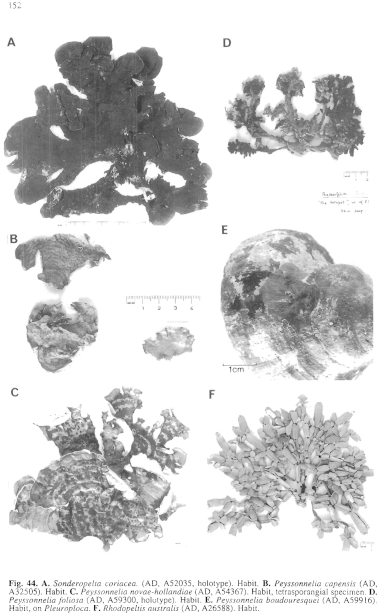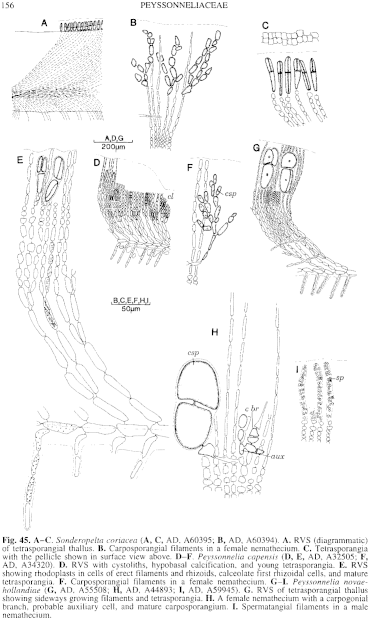|
|
|
|
|
|||||||||||
|
Electronic Flora of South Australia Species Fact Sheet
Phylum Rhodophyta – Class Florideophyceae – Order Gigartinales – Family Peyssonneliaceae
Selected citations: Chapman & Parkinson 1974: 158, fig. 48, pl. 51A. Denizot 1968: 123, figs 47–51,105,107(?). De Toni 1905: 1704. Marcot-Coqueugniot 1988: 301, figs 3–13. Millar 1990: 331, fig. 15D, E.
Synonyms
P. australis Sonder 1853: 685. De Toni 1905: 1699. Womersley & Sinkora 1981: 85.
P. australis Areschoug 1854: 352.
P. rubra sensu Harvey 1859b: 314 (in part).
P. gunniana J. Agardh 1876: 387. De Toni 1905: 1698. May 1965: 355.
Thallus (Fig. 44B) pale to medium red or grey-red, (1–) 2–5 (–12) cm across, cartilaginous, orbicular or becoming divided into 2–5 broad lobes, 230–450 µm thick, usually radially striate and with more or less concentric growth zones and granular inclusions apparent in surface view (magnified), epilithic and closely attached apart from free margins (or upper parts of larger plants) which often roll upwards on drying. Structure (Fig. 45D, E). Basal layer of radiating lines of cells, each cell 4–8 (–10) µm in diameter and L/D 2–4, producing from their lower side multicellular rhizoids (Fig. 45E) with their first cell (the hypobasal cell) inclined forwards and usually bent where it emerges from the thallus sheath (calceolate), sometimes cut off as a short, broad, hypobasal cell lying within the thallus sheath; hypobasal calcification present. Erect filaments (Fig. 45E) assurgent at 20–30 (–40)°, attached to the anterior upper side of the basal layer cells, 8–10 (–12) µm in diameter with cells L/D 2–4 below, branching from some to most of the first 4 cells, erect above and 6–8 µm in diameter with uppermost cells more or less isodiametric; cystoliths in small to relatively large clusters (Fig. 45D) of few to several adjacent cells in the mid to upper thallus region; surface calcification occasionally present.
Reproduction: Sexual plants with low, somewhat diffuse nemathecia, with slender paraphyses 200–250 µm and 8–10 cells long; carpogonial branches 3–4 cells long, lateral from basal cell of paraphyses; gonimoblasts (Fig. 45F) forming branched systems of elongate-ovoid cells 6–8 µm in diameter.
Tetrasporangial nemathecia superficial, low, medium yellow to dark red, 1–2 mm across and ovate to elongate, more or less in concentric lines; paraphyses 90–140 µm and 5–6 cells long; tetrasporangia (Fig. 45E) 50–60 µm long and 9–15 µm in diameter, decussately cruciately divided.
Type from Port Natal, S. Africa (Drege); in Herb. Montagne, PC.
Selected specimens: Parakeet I., Rottnest I., W. Aust., 1.5 m deep under ledge (Coleman 17, 18.i.1972; AD, A42358). Point Sinclair, S. Aust., low eulittoral pools (Womersley, 25.i.1951; AD, A 13895). Port Moorowie, Yorke Pen., S. Aust., 2–3 m deep (Cannon, 7.i.1989; AD, A59846). West Beach, S. Aust., 8 m deep (Shepherd, 8.vi.1968; AD, A32505). Vivonne Bay, Kangaroo I., S. Aust., 0–5 m deep on jetty piles (Kraft & Min-Thein, 4.xii.1971; AD, A41399). N side Pelican Lagoon, Kangaroo I., S. Aust., low eulittoral under ledge (Womersley, 16.i.1950; AD, Al2680). Oedipus Point, West I., S. Aust., 16 m deep (Shepherd, Dec. 1966; AD, A31143). 1.3 km off Middle Point, Cape Northumberland, S. Aust., 13 m deep (Shepherd, 19.iii.1974; AD, A44905). Koonya Bay, Mornington Pen., Vic., upper sublittoral pools (Womersley, 15.i.1974; AD, A44622). Crawfish Rock, Westernport Bay, Vic., 5 m deep (Watson, 26.iv.1969; AD, A34320, female) and at low tide level, shaded (Berthold, 14.ii.1990; AD, A60216 -"Marine Algae of southern Australia" No. 348). Tortoise Head, French I., Western Port, Vic., 2–3 m deep (Berthold, 15.ii.1990; AD, A60217, female). Walkerville, Vic., under overhang just above low tide (Sinkora A1522, 21.ii.1972; MEL 661576; AD, A42290). Hunter 1., NW Tas., upper sublittoral pools (Bennett, 14.i.1954; AD, A19664). N point of Stewarts Bay, Port Arthur, Tas., 1–2 m deep (McGeary-Brown, 29.x.1986; AD, A57387). Woody I., D'Entrecasteaux Ch., Tas., 10 m deep (Shepherd, 18.ii.1972; AD, A41686). Byron Bay, N.S.W., 16 m deep (Silvester, 18.viii.1973; AD, A43976).
Taxonomic notes: Distribution: S. Africa; Madagascar; New Zealand; Brazil.
In southern Australia, from Rottnest I., W. Aust., to northern N.S.W. and around Tasmania.
P. capensis is a common species, from low tide level (in shaded situations) to 38 m deep, and can be found fertile in most months but especially in winter to early summer. It is characterised by its habit, the presence of clusters of cystoliths in the mid to upper part of the thallus, and the rhizoids. The density and size of the cystolith clusters varies considerably but they are invariably present; in some specimens a second layer of cystoliths occurs in the upper thallus, and in specimens from Byron Bay, N.S.W., extra surface or just subsurface calcification occurs in a layer. The rhizoids also vary considerably in the shape of their first cell, but invariably it is inclined forward, basally swollen, and bent where it emerges from the sheath (i.e. calceolate in shape); in South African and south-east Australian specimens from rough-water coasts the base is usually cut off as a separate (hypobasal) cell within the sheath.
Specimens recorded from tropical-subtropical waters but lacking cystoliths (e.g. Weber-van Bosse 1921, p. 272; Womersley & Bailey 1970, p.306; Cribb 1983, p.39) are doubtfully of P. capensis. They are more similar to P. squamaria (S.G. Gmelin)Decaisne as described by Boudouresque & Denizot (1975, p. 14, figs 4–13) and Nozawa (1972, p. 2, figs 1, 2) who includes P. caulifera Okamura as a synonym. Yoshida (1975) regards P. caulifera as a distinct species, but illustrates cystolith granules and rhizoids which are typical of P. capensis.
P. capensis differs from P. squamaria in not always having the hypothallial rhizoidal cell cut off and in possessing cystoliths in clusters, P. squamaria being uncalcified; in other features, including the carposporophytes (cf. Nozawa 1972, figs 1F, 2) they are very similar.
Harvey confused two species under P. rubra in his Exsiccatae. His Tray. Set 316 from Western Port, Vic. (MEL, 676108) is P. capensis, but his Alg. Aust. Exsicc. 327 from Port Jackson, N.S.W. (MEL, 676109) is not this species but of the P. rubra structure.
References:
AGARDH, J.G. (1876). Species Genera et Ordines Algarum. Vol. 3, Part 1 - Epicrisis systematis Floridearum, pp. i-vii, 1–724. (Weigel: Leipzig.)
ARESCHOUG, J.E. (1854). Phyceae novae et minus cognitae in maribus extraeuropaeis collectae. Ups. Soc. Sci. nova Acta, Ser. III, 1, 329–72.
BOUDOURESQUE, C.-F. & DENIZOT, M. (1975). Révision du genre Peyssonnelia (Rhodophyta) en Méditerranée. Bull. Mus. Hist. Nat. Marseilles 35, 7–92.
CHAPMAN, V.J. & PARKINSON, P.G. (1974). The marine algae of New Zealand. Part DI: Rhodophyceae. Issue 3: Cryptonemiales. (Cramer: Germany.)
CRIBB, A.B. (1983). Marine algae of the southern Great Barrier Reef. Part I. Rhodophyta. (Aust. Coral Reef Soc., Handbook 2: Brisbane.)
DE TONI, G.B. (1905). Sylloge Algarum omnium hucusque Cognitarum. Vol. 4. Florideae. Sect. 4, pp. 1523–1973. (Padua.)
DENIZOT, M. (1968). Les Algues Floridées encroûtantes (a l'exclusion des Corallinacées). (Paris.)
HARVEY, W.H. (1859b). Algae. In Hooker, J.D., The Botany of the Antarctic Voyage. Flora Tasmaniae. Vol. II, pp. 282–320.
MARCOT-COQUEUGNIOT, J. (1988). Sur quelques Peyssonneliaceae (Rhodophyceae) récoltées en profundeur au large des côtes du Brésil. Vie Milieu 38, 299–309.
MAY, V. (1965). A census and key to the species of Rhodophyceae (red algae) recorded from Australia. Contr. N.S.W. natn. Herb. 3, 349–429.
MILLAR, A.J.K. (1990). Marine Red Algae of the Coffs Harbour Region, northern New South Wales. Aust. Syst. Bot. 3, 293–593.
MONTAGNE, C. (1847). Enumeratio fungorum quos a Cl. Drège in Africa meridionali collectos et in herbario Migueliano Servatos. Ann. Sci. Nat. 3 Sér. Bot., 7, 166–181.
NOZAWA, Y. (1972). Systematic anatomy of the Squamariaceae in the southern islands of Japan (3). Peyssonnelia squamaria (Gmelin)Decaisne. Bull. Jap. Soc. Phycol. 20, 1–6.
SONDER, O.W. (1853). Plantae Muellerianae. Algae. Linnaea 25, 657–709.
WEBER-VAN BOSSE, A. (1921). Liste des Algues du Siboga. II. Rhodophyceae. Part I. Protoflorideae, Némalionales, Cryptonemiales. Siboga-Expeditae, Monogr. Lab, pp. 187–310, Plates 6–8.
WOMERSLEY, H.B.S. & BAILEY, A. (1970). Marine algae of the Solomon Islands. Phil. Trans. R. Soc. Lond. B 259, 257–352.
WOMERSLEY, H.B.S. & SINKORA, D. (1981). Sonderophycus and the type specimen of Peyssonnelia australis (Cryptonemiales, Rhodophyta). Trans. R. Soc. S. Aust. 105, 85–87.
YOSHIDA, T. (1975). On the structural characteristics of Peyssonelia caulifera Okamura (Rhodophyceae, Squamariaceae) from Japan. Bull. Jap. Soc. Phycol. 23, 1–7.
The Marine Benthic Flora of Southern Australia Part IIIA complete list of references.
Publication:
Womersley, H.B.S. (14 January, 1994)
The Marine Benthic Flora of Southern Australia
Rhodophyta. Part IIIA, Bangiophyceae and Florideophyceae (to Gigartinales)
Reproduced with permission from The Marine Benthic Flora of Southern Australia Part IIIA 1994, by H.B.S. Womersley. Australian Biological Resources Study, Canberra. Copyright Commonwealth of Australia.
Illustrations in Womersley Part IIIA, 1994: FIGS 44B, 45 D–F.

Figure 44 enlarge
Fig. 44. A. Sonderopelta coriacea. (AD, A52035, holotype). Habit. B. Peyssonnelia capensis (AD, A32505). Habit. C. Peyssonnelia novae-hollandiae (AD, A54367). Habit, tetrasporangial specimen. D. Peyssonnelia foliosa (AD, A59300, holotype). Habit. E. Peyssonnelia boudouresquei (AD, A59916). Habit, on Pleuroploca. F. Rhodopeltis australis (AD, A26588). Habit.

Figure 45 enlarge
Fig. 45. A–C. Sonderopelta coriacea (A, C, AD, A60395; B, AD, A60394). A. RVS (diagrammatic) of tetrasporangial thallus. B. Carposporangial filaments in a female nemathecium. C. Tetrasporangia with the pellicle shown in surface view above. D–F. Peyssonnelia capensis (D, E, AD, A32505; F, AD, A34320). D. RVS with cystoliths, hypobasal calcification, and young tetrasporangia. E. RVS showing rhodoplasts in cells of erect filaments and rhizoids, calceolate first rhizoidal cells, and mature tetrasporangia. F. Carposporangial filaments in a female nemathecium. G–I. Peyssonnelia novae hollandiae (G, AD, A55508; H, AD, A44893; I, AD, A59945). G. RVS of tetrasporangial thallus showing sideways growing filaments and tetrasporangia. H. A female nemathecium with a carpogonial branch, probable auxiliary cell, and mature carposporangium. I. Spermatangial filaments in a male nemathecium.

|
Email Contact: State Herbarium of South Australia |

|